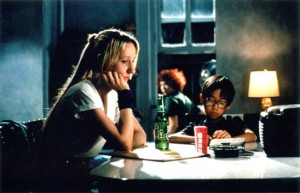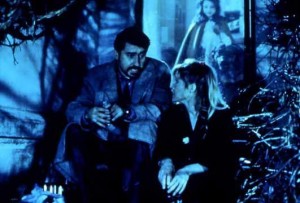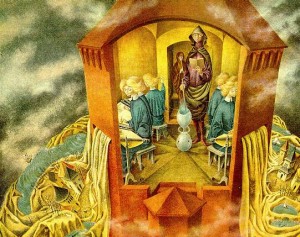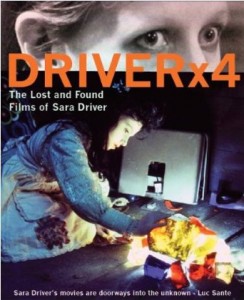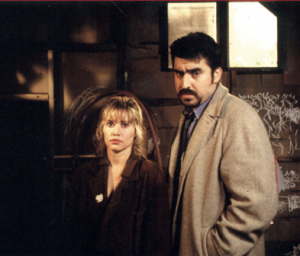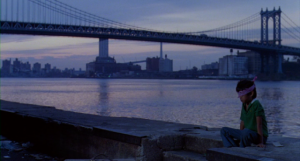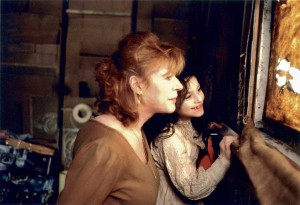Commissioned by MUBI for late October, 2019. — J.R.
In Sara Driver’s too small yet varied filmography, her two fiction features, both poetic fantasies — Sleepwalk (1986) and When Pigs Fly (1993) — are bracketed by two other longer films, the 48-minute You Are Not I (a brilliant adaptation of a Paul Bowles story about sisters, narrated by a schizophrenic, 1981) and the 78-minute documentary Boom for Real: The Late Teenage Years of Jean-Michel Basquiat (2017). Sleepwalk stars Suzanne Fletcher, who also played the schizophrenic sister in You Are Not I; Boom For Real portrays both a highly interactive community and an eclectic artist inside it, which might also describe When Pigs Fly, a comedy inspired by Topper about a jazz pianist (Alfred Molina) living in an east coast port town populated by barflies and ghosts. Moreover, the community in Boom is basically Lower East Side Manhattan and more specifically the Bowery, the setting of Sleepwalk, as well as the New York neighborhood where Driver has lived with Jim Jarmusch for well over three decades. (She produced his first two features, and plays one of the zombies in The Dead Don’t Die.)
I’ve known Driver since the 1980s, and suspect that one reason why she hasn’t become better known is that she’s both a woman and a surrealist, a combination that isn’t widely recognized in this country. In Mexican and Spanish painting, one could cite Frida Kahlo and Remedios Varo. (The latter, alas, is scarcely known in the U.S., but Thomas Pynchon began The Crying of Lot 49 with an extended description of one of her finest canvases.) But when it comes to fiction writers like Shirley Jackson or Flannery O’Connor, other labels such as “Gothic” or “Southern” take precedence, much as “feminist” does when it comes to Chantal Akerman, Jane Campion, and Věra Chytilová. Maybe all this is due to the abiding sexism of André Breton, Salvador Dalí, and other talented, macho Latin ideologues. Nowadays David Lynch and Raúl Ruiz are automatically deemed honorary members of the surrealist club while Driver is usually deprived of any tradition at all, except maybe “weird” and “independent.”
The French term fantastique — encompassing science fiction, comics, Surrealism, sword and sorcery, and other forms of fantasy — suggests a better fit for Driver. It’s a Cartesian attitude toward the imagination that’s distinctly different from the Anglo-American model. In our more empirical culture, reams of verbiage are devoted to distinguishing science fiction from fantasy, and legislating certain laws of etiquette to govern both — rules of internal consistency and narrative coherence decreeing that all breaches with recognizable reality stem from the same premises, whether these premises be scientific, purely fanciful, or some mixture of the two.
The French tend to be freer and looser about such matters, which helps to explain why such films as Les visiteurs du soir, Picnic on the Grass, Last Year at Marienbad, Je t’aime, je t’aime, Alphaville, Fahrenheit 451, Celine and Julie Go Boating, Deathwatch, Holy Motors, and High Life pose certain challenges to English and American temperaments that aren’t posed by The Wizard of Oz, Things to Come (1936), It’s a Wonderful Life, 2001: A Space Odyssey, The Exorcist, Star Wars, Close Encounters of the Third Kind, Blade Runner, Gravity, and Arrival. The most common objection to these French examples of fantastique might be, paradoxically, that they’re not “real” enough as stories — that the free-form quality of their inventions impedes the “natural” storytelling flow that we associate with the American and English examples.
What has all this to do with Sleepwalk, set in lower Manhattan, whose least sympathetic character is incidentally a young Frenchwoman? Or with When Pigs Fly, which is set in what looks like a New England coastal town but was actually filmed in Germany? Well, Sleepwalk won the prestigious Georges Sadoul Prize in France and enjoyed a respectable run in Paris yet passed practically unnoticed here, as did Driver’s second feature. Both films’ gorgeous visuals (Jarmusch shot much of Sleepwalk, and the late, great Robby Müller shot When Pigs Fly) and the blatant transparency of their free-floating fancies — their capacity to be enjoyed for their playful artifice — place them apart from most movies.
I once asked Driver about this convention-defying characteristic of hers, in a videotaped conversation we did for a Canadian DVD package issued by our mutual friend Ron Mann (Driver x 4: The Lost and Found Films of Sara Driver). She replied by bringing up a French filmmaker we both cherish who emigrated to the U.S.: “You know, I’m such a lover of Jacques Tourneur’s films, and I remember reading about him and how if you anchor things in a sense of reality, you can go anywhere from there.” This becomes especially true when a sense of reality is grounded in a solid grasp of character, so that the reality of, say, a frigid, newlywed Serbian fashion artist (Simone Simon) in Cat People (1942) and quite a few non-zombies in I Walked with a Zombie (1943), Tourneur’s first two pictures for Val Lewton — like that of the schizophrenic heroine in You Are Not I, a much saner heroine played by the same actress (Suzanne Fletcher) in Sleepwalk, and a schleppy but good-natured jazz musician (beautifully played by Molina) in When Pigs Fly –– helps us to accept many kinds of outlandishness in those films. It enables us to tolerate Sleepwalk’s Nikki (Fletcher) having a Chinese son, her room-mate Isabelle (Anna Magnuson) inexplicably losing all her hair, other characters losing fingers, or a dog belonging to the jazz pianist in When Pigs Fly having jazz dreams of his own that feature other musical dogs. In Sleepwalk, various machines can be said have communicative agendas of their own: in the copy shop where Nikki works, Xerox machines and phones seem to converse with one another, and a nocturnal elevator ride from that shop proceeds down seven flights, with the elevator inexplicably stopping to gaze at every floor. But what if we assume that machines can speak and listen to one another, and that elevators can enjoy their own rides? Like Alice’s fall down the rabbit hole or the poet’s glimpses of various rooms through keyholes in Cocteau’s The Blood of a Poet, this bracketing of diverse spectacles within a single trajectory encapsulates Driver’s method throughout.
A tenderness towards her characters is also worth noting. Being “haunted” in When Pigs Fly seems to mean having more friends than you thought you had. Some of the action takes place in a shabby Irish pub lorded over by Seymour Cassel, and when a barmaid gives Molina’s character an old rocking chair, he inherits a pair of ghosts (Marianne Faithfull and child actress Rachel Bella) along with it. On the surface, this gentle comedy seems worlds apart from the sinister aspects of Sleepwalk, but it’s intriguing to note some of the traits that unite them: dense, hyperactive, and musical soundtracks, downscale milieux, trancelike rhythms, a layered relation of distant past to present (bringing to mind that Driver spent her junior year in college abroad, studying archeology in Athens), bullying power-mongers and solitary children, the dreamy passivity of seemingly hapless protagonists, and the prominent attention given to their dreams. And eruptions of various kinds occurring in the midst of their compulsive routines, qualifying as surrealist explosions that convey the very essence of fantastique.

